How Do You Know if a Non Rebreather Mask Is Working
Chapter v. Oxygen Therapy
5.5 Oxygen Therapy Systems
Tissue oxygenation is dependent on optimal or adequate commitment of oxygen to the tissues. Increasing the concentration of inhaled oxygen is an effective method of increasing the partial force per unit area of oxygen in the blood and correcting hypoxemia. Simply stated, oxygen therapy is a means to provide oxygen according to target saturation rates (every bit per md orders or hospital protocol) to achieve normal or near normal oxygen saturation levels for acute and chronically ill patients (British Thoracic Society, 2008). Those administering oxygen must monitor the patient to keep the saturation levels within the required target range. Oxygen should be reduced or discontinued in stable patients with satisfactory oxygen saturation levels (Perry et al., 2014).
Hypoxemia or hypoxia is a medical emergency and should be treated promptly. Failure to initiate oxygen therapy can result in serious harm to the patient. The essence of oxygen therapy is to provide oxygen according to target saturation rates, and to monitor the saturation rate to proceed it within target range. The target range (SaO2) for a normal adult is 92% to 98%. For patients with COPD, the target SaO2 range is 88% to 92% (Alberta Health Services, 2015; British Thoracic Society, 2008; Kane, et al., 2013).
Although all medications given in the hospital require a prescription, oxygen therapy may be initiated without a physician order in emergency situations. Well-nigh hospitals will take a protocol in place to let health care providers to apply oxygen in emergency situations. The health care provider administering oxygen is responsible for monitoring the patient response and keeping the oxygen saturation levels within the target range.
The nigh common reasons for initiating oxygen therapy include acute hypoxemia related to pneumonia, shock, asthma, middle failure, pulmonary embolus, myocardial infarction resulting in hypoxemia, post-operative states, pneumonthorax, and abnormalities in the quality and quantity of hemoglobin. In that location are no contraindications to oxygen therapy if indications for therapy are nowadays (Kane et al., 2013).
Oxygen Delivery Systems
There is a wide variety of devices bachelor to provide oxygen support. Commitment systems are classified as low-catamenia or high-menstruum equipment, which provide an uncontrolled or controlled corporeality of supplemental oxygen to the patient (British Thoracic Society, 2008). Option should be based on preventing and treating hypoxemia and preventing complications of hyper-oxygenation. Factors such as how much oxygen is required, the presence of underlying respiratory affliction, age, the environment (at abode or in the hospital), the presence of an artificial airway, the need for humidity, a tolerance or a compliance trouble, or a need for consistent and authentic oxygen must be considered to select the correct oxygen delivery device (British Thoracic Order, 2008). Table v.2 lists the types of oxygen equipment.
| Types of Oxygen Equipment | Boosted Information | ||||||
| Nasal-cannula (low-menses system) | Nasal cannula consists of a minor bore tube connected to 2 short prongs that are inserted into the nares to supply oxygen directly from a catamenia meter or through humidified air to the patient. Information technology is used for short- or long-term therapy (i.e., COPD patients), and is best used with stable patients who require low amounts of oxygen. Advantages: Can provide 24% to 40% O2 (oxygen) concentration. Nearly mutual type of oxygen equipment. Can deliver O2 at ane to 6 litres per minute (L/min). It is convenient as patient can talk and eat while receiving oxygen. May exist drying to nares if level is above 4 Fifty/min. Like shooting fish in a barrel to apply, low cost, and disposable. Limitations: Easily dislodged, not as effective is a patient is a rima oris sabbatical or has blocked nostrils or a deviated septum or polyps. 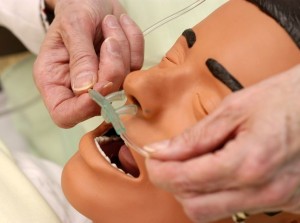 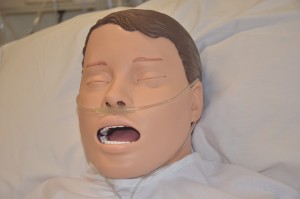 | ||||||
| Simple confront mask (low-flow system) | A mask fits over the oral fissure and olfactory organ of the patient and consists of exhalation ports (holes on the side of the mask) through which the patient exhales COii (carbon dioxide). These holes should always remain open up. The mask is held in place by an elastic around the back of the head, and it has a metal slice to shape over the olfactory organ to allow for a better mask fit for the patient. Humidified air may be attached if concentrations are drying for the patient. Advantages: Can provide 40% to threescore% Oii concentration. Flow meter should be set to evangelize O2 at half dozen to x Fifty/min. Used to provide moderate oxygen concentrations. Efficiency depends on how well mask fits and the patient'due south respiratory demands. Readily available on most hospital units. Provides higher oxygen for patients. Disadvantages: Difficult to eat with mask on. Mask may be circumscribed for some patients, who may feel claustrophobic with the mask on. 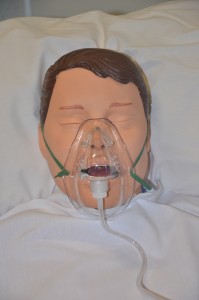 | ||||||
| Not re-breather mask (high-flow system) | Consists of a simple mask and a small reservoir bag attached to the oxygen tubing connecting to the menstruation meter. With a re-breather mask, there is no re-breathing of exhaled air. Information technology has a series of i-mode valves between the mask and the handbag and the covers on the exhalation ports. On inspiration, the patient just breathes in from the reservoir bag; on exhalation, gases are prevented from flowing into the reservoir pocketbook and are directed out through the exhalation ports. Advantages: With a adept fit, the mask can deliver betwixt 60% and 80% FiOtwo (fraction of inspired oxygen). The flow meter should be set up to evangelize O2 at 10 to 15 50/min. Flow charge per unit must exist loftier enough to ensure that the reservoir bag remains partially inflated during inspiration. Disadvantages: These masks have a risk of suffocation if the gas menstruation is interrupted. The handbag should never totally deflate. The patient should never be left alone unless the one-manner valves on the exhalation ports are removed. This equipment is used by respiratory therapists for specific curt-term, high oxygen requirements such as pre-intubation and patient transport. They are not bachelor on general wards due to: one. the chance of suffocation, two. the chance of hyper-oxygenation, and three. their possible lack of humidity. The mask also requires a tight seal and may be hot and confining for the patient. The mask volition interfere with talking and eating. 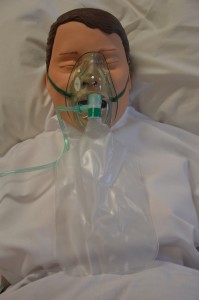 | ||||||
| Partial re-sabbatical mask (high-flow arrangement) | The purse should always remain partially inflated. The menses charge per unit should exist high enough to keep the bag partially inflated. Advantages: Can deliver 10 to 12 L/min for an O2 concentration of eighty% to 90%. Used short term for patients who crave high levels of oxygen. Disadvantages: The partial re-sabbatical bag has no one-style valves, so the expired air mixes with the inhaled air. The mask may exist hot and confining for the patient and will interfere with eating and talking.  | ||||||
| Face tent (low-flow system) | The mask covers the nose and mouth and does non create a seal around the nose. Advantages: Can provide 28% to 100% Oii Flow meter should be set up to deliver O2 at a minimum of xv L/min. Face tents are used to provide a controlled concentration of oxygen and increase moisture for patients who have facial burn down or a broken nose, or who are are claustrophobic. Disadvantages: It is difficult to achieve high levels of oxygenation with this mask. 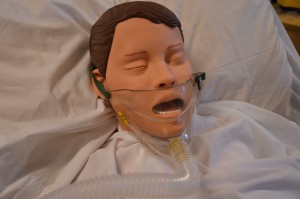 | ||||||
| Venturi mask (high-flow system) | Loftier-flow system consisting of a bottle of sterile water, corrugated tubing, a drainage bag, air/oxygen ratio nebulizer arrangement, and a mask that works with the corrugated tubing. The mask may be an droplets confront mask, tracheostomy mask, a T-slice, or a face up tent. The key is that the flow of oxygen exceeds the height inspiratory flow rate of the patient, and there is footling possibility for the patient to breathe in air from the room Advantages: The system can provide 24% to 60% Otwo at 4 to 12 L/min. Delivers a more precise level of oxygen by controlling the specific amounts of oxygen delivered. The port on the corrugated tubing (base of the mask) sets the oxygen concentration. Delivers humidified oxygen for patient condolement. It does not dry mucous membranes. Disadvantages: The mask may be hot and confining for some patients, and it interferes with talking and eating. Need a properly plumbing fixtures mask. Nurses may be asked to set up upwards a high-flow organization. In other instances, respiratory therapists may exist responsible for regulating and monitoring the loftier-catamenia systems. 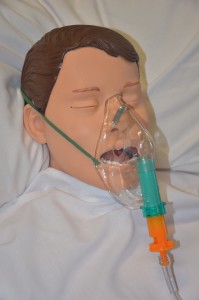 | ||||||
| Data source: Perry et al., 2014; Vancouver Coastal Health Authority, 2015 | |||||||
Special considerations:
- Review the protocol at your health authorisation prior to initiating any loftier-flow oxygen systems, and consult your respiratory therapist.
- In general, nasal prongs and a uncomplicated face up mask (low-flow oxygen equipment) may be practical past a health care provider. All other oxygen equipment (high-catamenia systems) must be set up and applied past a respiratory therapist.
- For patients with asthma, nebulizer treatments should use oxygen at a rate greater than half-dozen L/min. The patient should exist changed back to previous oxygen equipment when treatment is complete.
- Oxygenation is reduced in the supine position. Hypoxic patients should be placed in an upright position unless contraindicated (e.g., if they take spinal injuries or loss of consciousness).
- In full general, for about patients with COPD, target saturation is 88% to 92%. It is of import to recognize COPD patients are at take chances for hypercapnic respiratory failure.
- Check the function of the equipment and complete a respiratory assessment at least once each shift for low-flow oxygen and more often for high-flow oxygen.
- In acutely ill patients, oxygen saturation levels may require additional ABGs to regulate and manage oxygen therapy.
- Oxygen saturation levels and delivery equipment should be documented on the patient's chart.
Increasing Oxygen in the Lungs
The employ of oxygen delivery systems is only 1 component to increasing oxygen to the alveolar capillary bed to allow for optimal oxygenation to the tissues. Additional methods to increase oxygen saturation levels in the torso include (Perry et al., 2014):
- Maintaining satisfactory airway
- Optimizing oxygen-carrying capacities (hemoglobin levels)
- Reversing whatsoever respiratory depressants
- Using invasive or not-invasive ventilation when necessary
- Treating airflow obstruction with bronchodilators and sputum-clearing techniques
- Treating pulmonary edema as required
- Explain the difference between low- and high-menstruation oxygen systems.
- The reservoir bag on a non re-breather mask and a partial re-sabbatical mask must ever exist kept partially inflated. Why?
brandonburborpoes.blogspot.com
Source: https://opentextbc.ca/clinicalskills/chapter/5-5-oxygen-therapy-systems/
0 Response to "How Do You Know if a Non Rebreather Mask Is Working"
Post a Comment